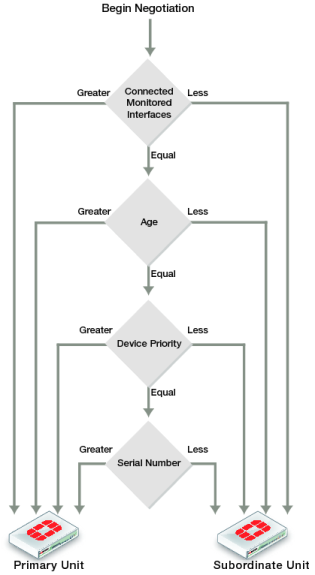Primary unit selection
Once FortiGate units recognize that they can form a cluster, the cluster units negotiate to select a primary unit. Primary unit selection occurs automatically based on the criteria shown in
Figure 188. After the cluster selects the primary unit, all of the remaining cluster units become subordinate units.
Negotiation and primary unit selection also takes place if a primary unit fails (device failover) or if a monitored interface fails or is disconnected (link failover). During a device or link failover, the cluster renegotiates to select a new primary unit also using the criteria shown in
Figure 188.
For many basic HA configurations primary unit selection simply selects the cluster unit with the highest serial number to become the primary unit. A basic HA configuration involves setting the HA mode to active‑passive or active-active and configuring the cluster group name and password. Using this configuration, the cluster unit with the highest serial number becomes the primary unit because primary unit selection disregards connected monitored interfaces (because interface monitoring is not configured), the age of the cluster units would usually always be the same, and all units would have the same device priority.
Using the serial number is a convenient way to differentiate cluster units; so basing primary unit selection on the serial number is predictable and easy to understand and interpret. Also the cluster unit with the highest serial number would usually be the newest FortiGate unit with the most recent hardware version. In many cases you may not need active control over primary unit selection, so basic primary unit selection based on serial number is sufficient.
In some situations you may want have control over which cluster unit becomes the primary unit. You can control primary unit selection by setting the device priority of one cluster unit to be higher than the device priority of all other cluster units. If you change one or more device priorities, during negotiation, the cluster unit with the highest device priority becomes the primary unit. As shown in
Figure 188 the FGCP selects the primary unit based on device priority before serial number. For more information about how to use device priorities, see
“Primary unit selection and device priority”.
The only other way that you can influence primary unit selection is by configuring interface monitoring (also called port monitoring). Using interface monitoring you can make sure that cluster units with failed or disconnected monitored interfaces cannot become the primary unit. See
“Primary unit selection and monitored interfaces”.
Finally, the age of a cluster unit is determined by a number of operating factors. Normally the age of all cluster units is the same so normally age has no effect on primary unit selection. Age does affect primary unit selection after a monitored interface failure. For more information about age, see
“Primary unit selection and age”.
This section describes:


